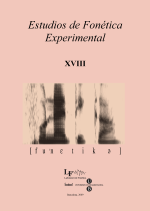El cine-MRI aplicado a la descripción de las sibilantes vascas
Keywords:
articulatory description, cine-MRI, sibilants, basque languageAbstract
This paper presents an articulatory analysis, based on cine-MRI, of the fricative moment of the Basque sibilant affricates (/ , / , / /). The results are compared with those obtained in a previous work on the sibilant fricatives (/ ,/ , / /), following the same methodology. This work presents an experimental articulatory description of the Basque subsystem of sibilant, which broadly coincides with the traditional one, although it also extends and goes into more detail in that description.
References
ALONSO, A. (1923): «Consonantes de timbre sibilante en el dialecto vasco baztanés», 3er. Congreso de Estudios Vascos, Imprenta de la Diputación de Guipúzcoa, San Sebastián, pp. 58-64.
ELEJABEITIA, A.; A. IRIBAR y R. M. PAGOLA (en prensa): «Nuevos datos acerca de la articulación de las sibilantes vascas», Language Design, vol. 9.
LARRASQUET, J. (1932): «Phonetique basque de Larraja (Quartier de Barcus)», RIEV, XXIII, pp. 153-191.
NAVARRO TOMÁS, T. (1923): «Observaciones fonéticas sobre el habla de Guernika», 3er. Congreso de Estudios Vascos, San Sebastián, pp. 49-56.
NAVARRO TOMÁS, T. (1925): «Pronunciación guipuzcoana», Homenaje a Menén- dez Pidal, III, pp. 593-653.
Downloads
Published
How to Cite
Issue
Section
License

This work is licensed under a Creative Commons Attribution-NonCommercial-NoDerivatives 4.0 International License.
All articles published online by Estudios de Fonética Experimental are licensed under Creative Commons Attribution-NonCommercial-NoDerivs 4.0 International (CC BY-NC-ND 4.0 DEED), unless otherwise noted. Estudios de Fonética Experimental is an open access journal. Estudios de Fonética Experimental is hosted by RCUB (Revistes Científiques de la Universitat de Barcelona), powered by Open Journal Systems (OJS) software. The copyright is not transferred to the journal: authors hold the copyright and publishing rights without restrictions. The author is free to use and distribute pre and post-prints versions of his/her article. However, preprint versions are regarded as a work-in-progress version used as internal communication with the authors, and we prefer to share postprint versions.




